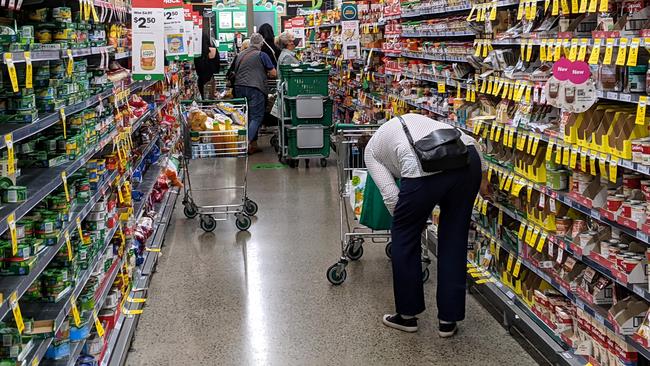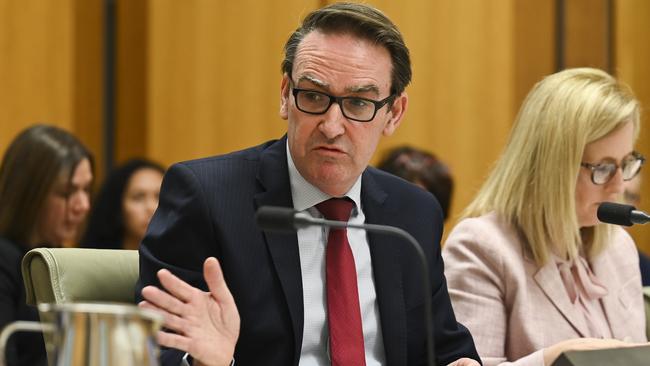Economy peaked late last year and it’s all downhill from here, Treasury boss Steven Kennedy says
Millions of Australians face a ‘challenging transition’ out of the post-lockdown boom, Treasury secretary Steven Kennedy warns.

Millions of struggling Australians should brace for a “challenging transition” out of the post-lockdown economic boom, Treasury secretary Steven Kennedy has declared, as leading economists warn the looming slowdown risks plunging the nation into its second recession in three years.
Dr Kennedy told Senate estimates on Tuesday the economy peaked in September last year, but that now “high domestic inflation and rising interest rates were squeezing household incomes and weighing on consumer spending”.
The warning from the government’s top economic official came as the chief executive of the country’s largest employer, Wesfarmers’ Rob Scott, agreed the “honeymoon is very much over” for the retailer, as surging mortgage repayments bite into household budgets and the spending tailwind from the Covid cash splash runs out of puff.
Mr Scott, who manages a number of the country’s biggest retail chains, such as Bunnings, Kmart, Coles, and Officeworks, said the nation’s dreadful productivity performance and Labor’s workplace reforms risked damaging the country’s economic potential.
Wages shine light on productivity problem
Dr Kennedy predicted pay growth by the end of this year would accelerate to its fastest pace since 2009 – but at 4 per cent still lag inflation.
Mr Scott said wages were “shining a light on productivity issues”. “The downturn in labour productivity coming out of Covid is quite a challenge for business to push wages up at a high level when productivity is going backwards,” he said.
“I am very concerned about the potential changes to industrial relations changes such as ‘same job, same pay’, removing the ability to use casual work, restrictions on the gig economy.
“All of these changes, if we are not careful, could remove a lot of flexibility in the workforce in the economy at a time when we really need flexibility.”

Dr Kennedy in his testimony said the economy was “transitioning to a more balanced position between supply and demand”.
“This transition will be challenging for many people,” the Treasury secretary said.
“Interest rates have risen sharply and are likely to remain elevated for a time, and inflation is unlikely to return to the RBA’s target band quickly.”
Interest rate pain hits differently
Dr Kennedy said the pain of rising interest rates and high cost of living differed across households. “For example, some households carrying a large mortgage or with limited savings are likely to be finding conditions challenging,” he said.
The May budget forecast year-average real GDP growth would slow from 3.25 per cent in this financial year, to 1.5 per cent in the next – in what would be the weakest financial year economic performance since 1991-92, when the nation was emerging from a damaging recession.
AMP Capital chief economist Shane Oliver said the sharp deterioration in economic conditions, when placed in the historic context, suggested predictions of only a small increase in unemployment could prove optimistic.
Dr Oliver said he believed Australia could narrowly avoid a recession, but the risk of another severe downturn was a not insignificant 45 per cent. With population growth anticipated to lift by 2 per cent in this financial year, and 1.7 per cent in the next, he said the country would “slide into a per-capita recession”.
Home building approvals collapse
“When you do that, people’s living standards are going backwards and people feel like they are worse off. Then it can be a precursor to an actual recession,” he said.
As shopping begins to contract, new figures show the number of home building approvals in April collapsed to the lowest since 2012, down nearly 25 per cent on a year earlier.
Treasury officials forecast this year and next would be the weakest for the global economy in two decades, outside the Covid-19 pandemic and the GFC. Dr Kennedy said the outlook risks were “tilted to the downside”.
“Australia’s economy is not immune to these global challenges but is well placed to navigate them,” he said, pointing to near 50-year lows in unemployment and still strong labour demand.
KPMG chief economist Brendan Rynne agreed the best times for the economy had passed, for this cycle at least, but he said he did not anticipate Australia would stumble back into recession.
Dr Rynne said the risk of two consecutive quarters of shrinking GDP – the technical definition of a recession – were real and at their highest through the second half of 2023. “Our forecasts are for very slim quarterly growth, and it’s not going to take much to tip that down if you get even a slight shock through some form or another, so that’s the problem,” he said.
But there was also the prospect that China again propped up Australia’s economy should officials in Beijing choose to stimulate growth rates lagging the targets in the country’s five-year plan.
Still, Dr Rynne said it was “very weird” that such a historically major slowdown was not expected to be accompanied by a large increase in unemployment. Indeed, an overheated labour market is only anticipated to return to full employment, in the realms of 4-4.5 per cent.
“It’s the recession we are having when we are not having a recession,” he said.
Household savings buffer
Despite Mr Scott’s warnings, Dr Rynne said it was likely the economy was going to be buoyed by “the drawdown of savings that we have amassed over the past few years”.
“In previous downturns we might not have had the same level of savings in which to act as a buffer in more difficult circumstances,” he said.
The number of home building approvals in April collapsed to the lowest since 2012, and down nearly 25 per cent on a year earlier.
CBA senior economist Belinda Allen said the decade-low 11,600 approvals last month were even more shocking in the context of the surge in net migration.
Ms Allen said the last peak in monthly approvals of 22,000 in April 2016 came when the pace of population growth was about 1.6 per cent, compared with 2 per cent now.
“The lack of new supply at a time when vacancy rates are low, household formation rates remain well below pre-pandemic levels and (at a time of) rapid population growth will mean rents, and home prices will continue to face upward pressure,” Ms Allen said.
Dr Kennedy said the “faster than anticipated” recovery in net migration this year had “compounded” the challenges in the rental market, where vacancy rates are near record lows of just above 1 per cent.
The consumer price index had rent climbing by nearly 5 per cent in the year to March.
With advertised rents rising by 10 per cent, Dr Kennedy said “the lift in advertised rents will gradually flow through to average rental costs, as existing lease agreements are renewed”.






To join the conversation, please log in. Don't have an account? Register
Join the conversation, you are commenting as Logout